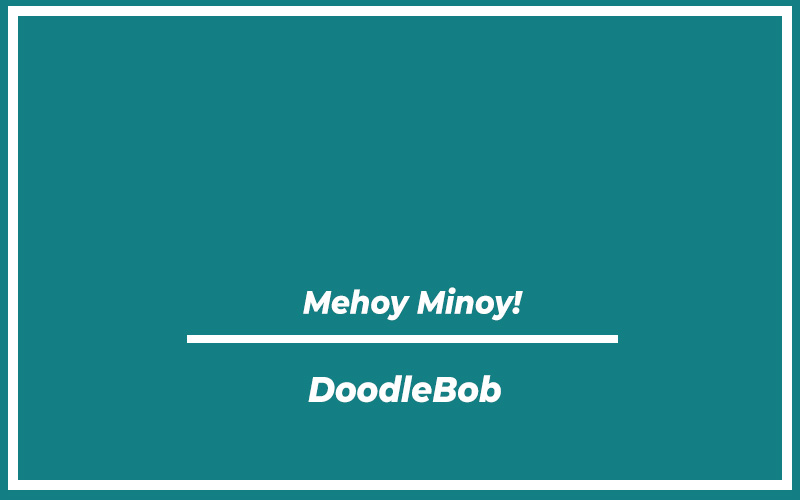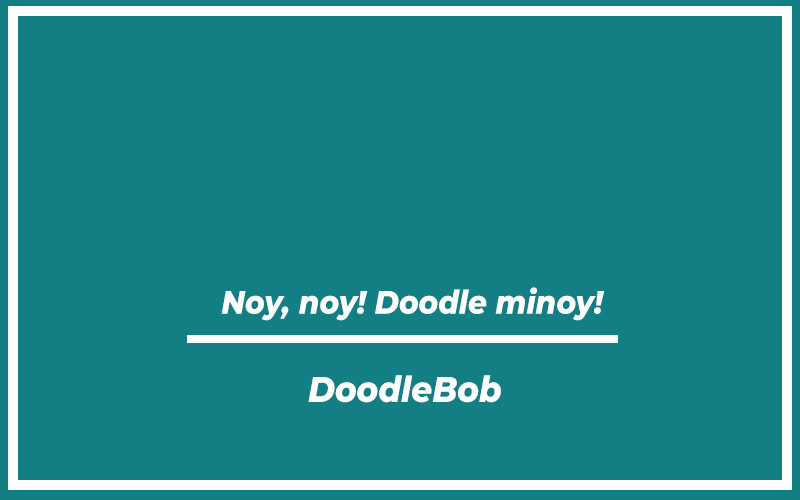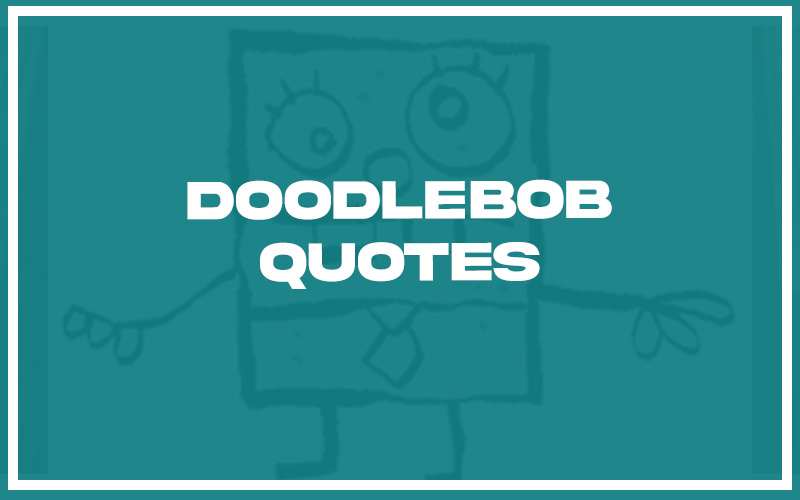If you’re a fan of the quirky and whimsical world of SpongeBob SquarePants, then you’ll definitely get a kick out of DoodleBob’s quotes.
This mischievous character, created from a magic pencil, speaks in a hilariously nonsensical jabber that’s both memorable and endearing.
DoodleBob’s phrases might not make much sense on the surface, but they capture the fun and chaos he brings to Bikini Bottom. As you dive into DoodleBob’s quotes, you’ll find yourself chuckling at the absurdity and creativity that are hallmarks of the show’s humor.
Best Doodlebob Quotes

Mehoy Minoy!” – DoodleBob
DoodleBob’s phrase “Mehoy Minoy!” might seem nonsensical, but it captures his essence—chaotic, mysterious, and unpredictable. Although the words don’t convey a clear message, they reflect the character’s unique contribution to the whimsical world of “SpongeBob SquarePants”.
This expression reminds us of the unexpected joys and humor that seemingly absurd moments can bring into storytelling, encouraging viewers to find delight in the nonsensical. It celebrates the idea that entertainment and laughter often come from the most unexpected sources, enriching our viewing experience by embracing the sheer unpredictability of the characters and their interactions.
Also Read: Macho Man Randy Savage Quotes (with Explanation)
“Hinga Dinga Durgen!” – DoodleBob
“Hinga Dinga Durgen!” while another set of gibberish, humorously underscores DoodleBob’s whimsical nature. This phrase enhances the charm of the “SpongeBob SquarePants” series, where even nonsensical elements contribute to its universal appeal. It serves as a light-hearted reminder to not take life too seriously and to appreciate moments of levity and silliness.
This approach to language and communication in the show encourages audiences to enjoy life’s lighter side, where understanding is less important than the joy and community that shared laughter can bring.
“Bala Bala!” – DoodleBob
“Bala Bala!” likely represents DoodleBob’s expression of excitement or aggression. This phrase exemplifies the power of non-verbal communication, demonstrating that emotion and intent can often transcend spoken language.
It reminds us that expressions of feeling do not always need to be articulated through conventional words but can be effectively conveyed through sounds and actions, resonating with audiences on a primal level. This form of communication is particularly impactful in visual media, where the emotional context can be understood universally, transcending linguistic barriers.
“Ne hoy, ne hoy!” – DoodleBob
DoodleBob’s “Ne hoy, ne hoy!” might sound like simple gibberish, but it adds a layer of intrigue and mystique to his character. It suggests a sort of personal mantra or quirky utterance that makes him more memorable.
This repetitive vocalization draws viewers’ attention and can be seen as a form of musical expression within language, showcasing how rhythmic and repetitive sounds contribute to character development and audience engagement. It highlights the creativity in voice acting and character design, where even nonsensical sounds become an integral part of the show’s charm.
“Rah rah rah rah rah!” – DoodleBob
DoodleBob’s chant “Rah rah rah rah rah” during confrontations encapsulates his aggressive demeanor and adds depth to his interactions with SpongeBob. This expression of raw, primal emotion showcases how conflicts in even the most lighthearted contexts are expressed through universal sounds of exertion and challenge.
It teaches us about the expressive power of simple vocalizations to convey conflict and emotion, serving as a reminder of the basic human and emotional connections that can be communicated even through minimalistic language.
“Aaaah, hahaha!” – DoodleBob
DoodleBob’s laughter, despite his generally antagonistic role, highlights the universal nature of laughter and its ability to connect diverse audiences. His laughter, though emerging from mischievous contexts, is contagious and illustrates the complexity of characters who are capable of both causing trouble and expressing genuine joy.
This sound reminds us that characters are multifaceted, and their expressions can convey a wide range of emotions that resonate with viewers, bridging gaps between character and audience through shared human expressions.
“No! Nooo!” – DoodleBob
DoodleBob’s vocal protest “No! Nooo!” embodies universal themes of resistance and defiance. This simple declaration is a powerful expression of frustration and opposition, resonating with anyone who has ever felt compelled to stand against something.
It emphasizes the importance of having a voice and using it to express dissent, showcasing that even the most straightforward expressions have significant emotional impact and can be profoundly relatable. This reinforces the value of speaking out, regardless of the simplicity of the words used, in making one’s feelings known and standing firm in one’s beliefs.
“Mehoy menoy hoy minoy!” – DoodleBob
DoodleBob’s distinctive exclamation, “Mehoy menoy hoy minoy!” is an iconic line that captures his quirky and enigmatic character. Although devoid of any conventional meaning, this phrase exemplifies how sounds and intonations can contribute to character identity in animation, making DoodleBob memorably peculiar and entertaining.
It emphasizes the creative use of voice to express personality and emotion in storytelling, inviting audiences to appreciate the imaginative aspects of language that go beyond traditional verbal communication.
“Hoy, me hoy!” – DoodleBob
“Hoy, me hoy!” is another example of DoodleBob’s nonsensical but character-defining utterances. This phrase, though cryptic, reflects his playful and mischievous nature, enhancing his role as a whimsical antagonist in “SpongeBob SquarePants.”
It showcases the creative liberties taken in animation to develop unique characters through unconventional means. This type of communication challenges the audience to find humor and joy in the absurd, celebrating the diversity of character voices in animated storytelling.
“Mehoy hoy hoy!” – DoodleBob
“Mehoy hoy hoy!” by DoodleBob adds to the playful chaos he embodies. This nonsensical utterance enriches the character’s mysterious and unpredictable aura, reinforcing his role as a disruptive but amusing presence.
It highlights the show’s ability to engage audiences through imaginative and humorous language that doesn’t need to adhere to logical structures, thereby enhancing the fantastical elements of the SpongeBob universe.
“Doodle doodle! Doo!” – DoodleBob
With “Doodle doodle! Doo!”, DoodleBob communicates in a manner that complements his drawn, doodle-like existence. This expression not only serves as a verbal signature that echoes his animated nature but also plays into the theme of living drawings interacting in a human-like manner.
It reminds viewers of the creative possibilities within animation, where even the simplest forms can be endowed with vibrant life and personality.
“Me hoy minoy nahoy!” – DoodleBob
“Me hoy minoy nahoy!” continues the trend of DoodleBob’s endearing gibberish, adding depth to his character through sounds that imply emotion and intention without traditional language.
This phrase enriches the texture of his interactions, providing both humor and a touch of unpredictability, which keeps viewers engaged and entertained by his antics.
“Nooy nooy nooy!” – DoodleBob
DoodleBob’s “Nooy nooy nooy!” exemplifies his unique method of communication, which, while nonsensical, is distinctively expressive. This line plays a critical role in defining his interactions, allowing him to express disagreement or distress in a manner that is uniquely his own.
It underscores how animation can use non-standard linguistic forms to convey complex emotions and reactions in a way that is both universal and uniquely tailored to the character’s personality.
“Nehoy Menoy!” – DoodleBob
“Nehoy Menoy!” by DoodleBob is perhaps one of his most recognizable phrases, encapsulating his essence in two simple yet mysterious words. This phrase has become a cultural reference point, highlighting how even the most nonsensical expressions can create a lasting impact.
It emphasizes the power of unique character trademarks in animation, contributing to the show’s iconic status and demonstrating how character-specific quirks can enhance memorability and endear characters to audiences.
“Hoy noy, doodle!” – DoodleBob
DoodleBob’s playful exclamation, “Hoy noy, doodle!” exemplifies his whimsical and chaotic nature. This phrase, while seemingly nonsensical, captures the essence of his character as a doodle come to life, adding a layer of creativity and unpredictability to the narrative.
It showcases how unique vocal expressions can define a character’s identity and enhance the storytelling experience, encouraging viewers to embrace the imaginative possibilities of animated characters.
“Doodle, doodle, hoy!” – DoodleBob
“Doodle, doodle, hoy!” by DoodleBob is an expression of his spirited personality. This chant-like phrase emphasizes his animated, almost musical way of interacting with the world around him.
It highlights the playful use of language in “SpongeBob SquarePants,” where even the simplest phrases are turned into catchy, memorable hooks. This approach enriches the viewer’s experience by blending visual and verbal elements to create a fun and engaging atmosphere.
“Hoy minoy, doodle doo!” – DoodleBob
“Hoy minoy, doodle doo!” further solidifies DoodleBob’s role as a character whose language is as unconventional as his appearance. This quirky utterance reflects his lively and impulsive traits, bringing a unique flavor to each episode he appears in.
It challenges conventional dialogues and showcases the series’ commitment to fostering a creative environment where language is an art form itself, playful and boundlessly inventive.
“Noy noy, me hoy!” – DoodleBob
With “Noy noy, me hoy!” DoodleBob continues to communicate in his signature style that is both intriguing and endearing to audiences. This phrase, characterized by its rhythmic and repetitive structure, enhances his role as a comic relief character.
It demonstrates how effective non-traditional language can be in creating laughter and delight, proving that words do not need to be understood in the traditional sense to contribute significantly to the humor and charm of a show.
“Minoy minoy, hoy!” – DoodleBob
“Minoy minoy, hoy!” captures DoodleBob’s essence with its repetitive and melodic sound, which makes him one of the most memorable characters in the series. This line showcases his ability to communicate effectively despite the unconventional language, adding depth to his character and enriching the narrative with his unique linguistic style.
It highlights the creative potential of voice acting in animation, where even non-lexical utterances can convey a wide range of emotions and intentions.
“Doodle hoy, noy noy!” – DoodleBob
“Doodle hoy, noy noy!” is another example of how DoodleBob uses his unique dialect to express his feelings and reactions. This phrase, while playful, also serves to assert his presence and influence within the scene, demonstrating his ability to impact the storyline through his distinctive mode of communication.
It reflects the innovative approach to character development in animation, where the voice itself becomes an integral part of the character’s identity.
“Hoy! Doodle, doodle noy!” – DoodleBob
“Hoy! Doodle, doodle noy!” by DoodleBob is emblematic of his vibrant and energetic personality. This expression, with its lively and engaging tone, contributes to the overall dynamism of his character, making him a standout figure in the series.
It emphasizes the importance of vocal delivery in animation, where even non-standard expressions can become a source of entertainment and engagement for the audience, enhancing the show’s appeal and memorability.
“Doodle noy, hoy minoy!” – DoodleBob
“Doodle noy, hoy minoy!” encapsulates DoodleBob’s playful yet chaotic spirit. This expression, like his others, is devoid of conventional meaning but rich in character flavor. It exemplifies the playful linguistic creativity of “SpongeBob SquarePants,” where even nonsensical phrases add depth and humor.
This particular phrase showcases DoodleBob’s capacity to be both amusing and mystifying, reminding viewers that dialogue in animation doesn’t always have to adhere to logic to be effective or engaging.
“Minoy! Hoy, doodle noy!” – DoodleBob
“Minoy! Hoy, doodle noy!” further demonstrates DoodleBob’s unique language, serving as a trademark of his unpredictable nature. This phrase enriches his interactions within the show, providing comedic relief and contributing to the series’ whimsical charm.
It illustrates how specific sounds and patterns, even when nonsensical, can become signature elements of a character’s identity, enhancing their memorability and the show’s overall creative expression.
“Hoy! Minoy doodle!” – DoodleBob
“Hoy! Minoy doodle!” reflects DoodleBob’s energetic and impulsive characteristics. This phrase, though simple, is delivered with a gusto that captures his essence as a mischievous doodle come to life.
It’s a prime example of how vocal expressions, irrespective of their literal meaning, can convey personality traits and add to a character’s role within a narrative, making each of DoodleBob’s appearances uniquely entertaining.
“Doodle! Hoy minoy, noy!” – DoodleBob
“Doodle! Hoy minoy, noy!” by DoodleBob is a playful and catchy phrase that adds to his enigmatic yet charismatic persona. This line showcases the creativity of the show’s writers in crafting a character who communicates effectively through a language of his own creation.
It emphasizes the fun and imaginative aspects of character design and dialogue that engage audiences, especially younger viewers, in a deeply visual and auditory way.

“Noy, noy! Doodle minoy!” – DoodleBob
“Noy, noy! Doodle minoy!” is another iconic utterance that reinforces DoodleBob’s presence as a delightful disruptor in the series. This phrase highlights the inventive use of sound to express the character’s emotions and reactions, providing a layer of communication that transcends traditional language barriers.
It exemplifies the inventive ways animation can explore and expand the possibilities of narrative and character interaction.
“Minoy, doodle! Hoy noy!” – DoodleBob
“Minoy, doodle! Hoy noy!” continues to build on DoodleBob’s distinctive linguistic style, offering a rhythmic and memorable line that resonates with fans for its sheer nonsensical charm.
This expression underlines how animation can play with sound to create lines that are both nonsensical and musically engaging, contributing to the character’s appeal and the auditory landscape of the show.
“Hoy doodle, minoy noy!” – DoodleBob
“Hoy doodle, minoy noy!” encapsulates the whimsical and chaotic essence of DoodleBob. This phrase, characteristic of DoodleBob’s speech pattern, adds a layer of humor and unpredictability to his character, enhancing his role as both a comic and chaotic element within the narrative.
It underscores the show’s ability to use unconventional dialogue as a tool for character development and audience engagement, making DoodleBob a memorable and beloved figure in the series.
Final Thoughts
DoodleBob’s quotes, while seemingly gibberish, remind us of the joy found in the simple and the silly. As you reflect on these playful utterances, let them inspire you to embrace a lighter side of life, where not everything needs to be understood to be enjoyed.
Remember, sometimes a good laugh and a bit of nonsense are just what you need to brighten your day. Let DoodleBob’s peculiar language encourage you to find happiness in the chaos and to always keep a sense of humor close at hand.

